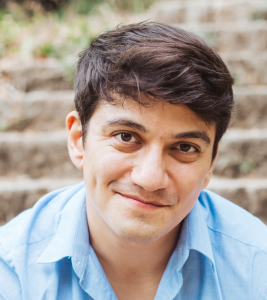Matthew Akamatsu, PhD
Arnold O. Beckman Postdoctoral Fellow
Awardee, 2020 ASCB Porter Prize for Research Excellence for Postdocs
Awardee, 2020 Outstanding Postdoc Award, UC Berkeley Department of Molecular and Cellular Biology, Division of Cell and Developmental Biology
K99 Pathway to Independence Award recipient (NIGMS)
Matt combines mathematical modeling, human stem cell genome-editing, and fluorescence microscopy to study how actin produces force to function in cellular membrane trafficking processes.
He currently has two projects:
1) Understand the relationship between actin cytoskeletal architecture and mechanical function at sites of mammalian clathrin-mediated endocytosis by integrating agent-based mathematical modeling alongside measurements from purified proteins (collaboration with labmate Leanna Owen) and cryo-electron tomography (collaboration with labmate Daniel Serwas)
2) Understand how SARS-CoV-2 nonstructural proteins manipulate cellular organelle and membrane trafficking processes to make double-membrane genomic replication compartments, in collaboration with members of the Drubin/Barnes, Hurley, Schoeneberg, Betzig and Upadhyayula labs
PhD: Department of Molecular Biophysics and Biochemistry, Integrated Program in Physics, Engineering and Biology, Yale University, lab of Tom Pollard
Matt will be starting a lab at the University of Washington Department of Biology starting June 2022.
https://scholar.google.com/citations?user=uNrsMygAAAAJ&hl=en
Publications
- Value of models for membrane budding. Lee C. T., Akamatsu M., Rangamani P. Curr. Opin. Cell Biol. 71, 38–45 (2021). https://doi.org/10.1016/j.ceb.2021.01.011
- Adaptive actin organization counteracts elevated membrane tension to ensure robust endocytosis. Kaplan C., Kenny S. J., Chen S., Schöneberg J., Sitarska E., Diz-Muñoz A., Akamatsu M.*, Xu K.*, Drubin* D. G. In revision. (*co-corresponding author) https://doi.org/10.1101/2020.04.05.026559
- Mechanistic insights into actin function during clathrin-mediated endocytosis via in situ cryo-electron tomography. Serwas D., Akamatsu M., Moayed A., Vasan R., Vegesna K., Hill J., Schoeneberg J., Davies K. M., Rangamani P., Drubin D. G. In review. https://doi.org/10.1101/2021.06.28.450262
- Principles of self-organization and load-adaptation by the actin cytoskeleton during clathrin-mediated endocytosis. Akamatsu M., Vasan R., Serwas D., Ferrin M., Rangamani P., Drubin D. G. eLife 9, e49840 (2020). https://doi.org/10.7554/eLife.49840
- A mechanical model reveals that non-axisymmetric buckling lowers the energy barrier associated with membrane neck constriction. Vasan R., Rudraraju S., Akamatsu M., Garikipati K., Rangamani P. Soft Matter 279, 679–14 (2020). https://doi.org/10.1039/C9SM01494B
- Intracellular Membrane Trafficking: Modeling Local Movements in Cells. SIAM (2018). Vasan R., Akamatsu M.,and Rangamani P. Cell Movement, Modeling and Simulation in Science, Engineering and Technology. https://doi.org/10.1007/978-3-319-96842-1_9
- Lou H.S., Zhao W., Li X, Duan L, Powers A, Akamatsu M., Santoro F, McGuire A, Cui Y, Drubin D. G., Cui B. Membrane curvature underlies actin reorganization in response to nanoscale surface topography. Proc Nat Acad Sci 201910166 (2019). https://doi.org/10.1073/pnas.1910166116
- Genome-edited human stem cells expressing fluorescently labeled endocytic markers allow quantitative analysis of clathrin-mediated endocytosis during differentiation. Dambournet D., Sochacki K.A., Cheng A., Akamatsu M.,Taraska J.W., Hockemeyer D., Drubin D.G. J Cell Biol 217, 3301–3311 (2018). https://doi.org/10.1083/jcb.201710084
- Akamatsu M., Lin Y., Bewersdorf J., Pollard T. D. Analysis of interphase node proteins in fission yeast by quantitative and super resolution fluorescence microscopy. Mol Biol Cell 28, 3203–3214 (2017). https://doi.org/10.1091/mbc.e16-07-0522
- Zhao W., Hanson W, Lou, H.S., Akamatsu M., Chowdary P. M., Santoro F, Marks J. R., Grassart A, Drubin D. G., Cui Y, Cu, B. Nanoscale manipulation of membrane curvatures for probing endocytosis in live cells. Nature Nanotechnology 11, 822 (2017). https://doi.org/10.1038/nnano.2017.98
- Pu K. M., Akamatsu M., & Pollard T. D. The septation initiation network controls the assembly of type 1 cytokinesis nodes in fission yeast. J Cell Sci 128, 441–446 (2015). https://doi.org/10.1242/jcs.160077
- Akamatsu M., Berro J., Pu K. M., Tebbs I. R., Pollard T. D. Cytokinetic nodes in fission yeast arise from two distinct types of nodes that merge during interphase. J Cell Biol 204, 977–988 (2014). http://doi.org/10.1083/jcb.201307174
- McCormick, C. D., Akamatsu, M. S., Ti, S.-C. & Pollard, T. D. Measuring Affinities of Fission Yeast Spindle Pole Body Proteins in Live Cells across the Cell Cycle. Biophysj 105, 1324–1335 (2013). https://doi.org/10.1016/j.bpj.2013.08.017
